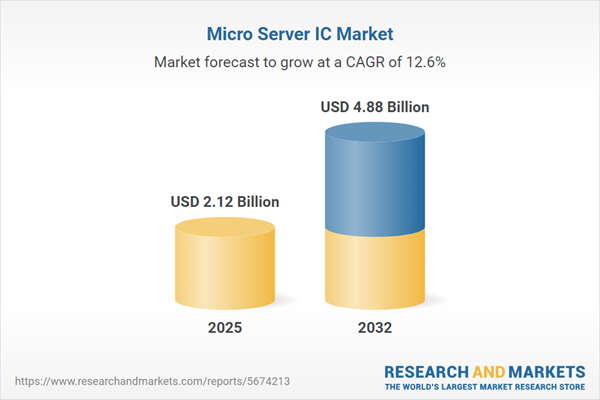Speak directly to the analyst to clarify any post sales queries you may have.
Micro server integrated circuits (ICs) are redefining how enterprises build, manage, and scale digital infrastructure in a dynamic business landscape. As organizations seek agility and resilience, these components power secure, distributed IT ecosystems and enable proactive adaptation to evolving operational requirements.
Market Snapshot: Micro Server Integrated Circuits Market Trends
The micro server integrated circuits market is progressing steadily with rising adoption among enterprises prioritizing cloud, edge, and distributed computing solutions. Valued at USD 1.88 billion in 2024, the sector reflects strong demand for advanced processing capabilities as companies modernize IT operations. Trends shaping this growth include the deployment of distributed architectures, scaling of artificial intelligence initiatives, and focus on operational efficiency. Industry leaders are advancing IC architecture and leveraging innovative process technologies, ensuring products align with digital transformation imperatives. This secures technology differentiation and long-term ecosystem resilience for enterprise buyers.
Scope & Segmentation: Micro Server Integrated Circuits
- Architecture Types: Enterprises benefit from Arm, Risc-V, and X86 architectures, tailoring infrastructure to match specialized workloads and offering flexibility for rapid environmental changes.
- End User Applications: Implementations span public, private, and hybrid cloud environments as well as edge computing, supporting improved functionality in sectors such as telecommunications, manufacturing, and retail.
- Technology Nodes: Manufacturing nodes from 7Nm to 22Nm enable businesses to optimize for energy efficiency, processing capabilities, and sustainability within IT operations.
- Packaging Types: Modular designs—including chiplet-based solutions, multi-chip modules, and system-on-chip packaging—support scalable deployments and ease infrastructure evolution as organizational needs expand.
- Distribution Channels: Enterprises access ICs via direct procurement, specialized distributors, established partners, digital platforms, and original equipment manufacturer relationships, which strengthens supply reliability and purchasing agility.
- Regional Coverage: Adoption patterns and operational strategies are shaped by regulatory differences, infrastructure initiatives, and business practices across the Americas, EMEA, and Asia-Pacific. Regional dynamics influence procurement frameworks and enterprise investment decisions.
- Key Market Players: Sector leadership and product reliability are reflected through companies such as Intel Corporation, Advanced Micro Devices Inc., Ampere Computing LLC, Marvell Technology Inc., Qualcomm Incorporated, Huawei Technologies Co. Ltd, Loongson Technology Corporation Limited, Fujitsu Limited, Alibaba Group Holding Limited, and Oracle Corporation.
Key Takeaways for Senior Decision-Makers
- Distributed and sustainable IT models elevate organizational flexibility and allow for efficient support of remote and decentralized business units.
- Incorporation of open-source frameworks and multi-processor systems accelerates adaptation to evolving technology and market needs, allowing for swift integration and operational pivoting.
- Adoption of modular and chiplet-based packaging improves scalability, helping to future-proof infrastructure investments and optimize resource allocation as workloads grow.
- Diversified supplier networks and partner ecosystems enhance operational stability, reducing risks associated with procurement disruptions.
- Environmental compliance and adherence to regulatory frameworks are playing a larger role in shaping IT infrastructure strategies, supporting sustainable investment priorities.
- Consistent reduction of latency is vital in maintaining secure, real-time data flow for distributed cloud and edge environments, supporting seamless enterprise performance.
Impact of 2025 U.S. Tariffs: Supply Chain and Cost Dynamics
Anticipated 2025 U.S. tariffs are prompting enterprises to reexamine micro server integrated circuit sourcing and supplier agreements. Organizations are expanding supplier networks and refining procurement frameworks in response to shifting trade norms. Enhanced inventory practices and flexible supply strategies are now essential to maintain business continuity and stability. These adaptive measures help manage cost risks and reduce vulnerabilities, supporting sustained infrastructure development as the global trade landscape evolves.
Methodology & Data Sources
This research synthesizes insight from semiconductor experts, technical documentation, and validated industry performance metrics. A focus on methodological rigor enables actionable recommendations, giving executives and technical decision-makers the clarity to make strategic choices on micro server IC deployment.
Why This Report Matters for Senior Leaders
- Empowers executive teams to anticipate regulatory, supply chain, and technology changes in the micro server integrated circuits market, supporting proactive planning and risk management.
- Aligns IT investments with sustainability mandates and innovation agendas, reinforcing competitiveness in evolving enterprise environments.
- Prepares organizations to efficiently manage procurement and infrastructure resilience challenges linked to ongoing market and policy shifts.
Conclusion
This report delivers actionable segmentation and strategic insight, equipping senior decision-makers to optimize digital infrastructure strategies and build resilience as technology and business priorities evolve.
Additional Product Information:
- Purchase of this report includes 1 year online access with quarterly updates.
- This report can be updated on request. Please contact our Customer Experience team using the Ask a Question widget on our website.
Table of Contents
3. Executive Summary
4. Market Overview
7. Cumulative Impact of Artificial Intelligence 2025
Companies Mentioned
The companies profiled in this Micro Server IC market report include:- Intel Corporation
- Advanced Micro Devices, Inc.
- Ampere Computing LLC
- Marvell Technology, Inc.
- Qualcomm Incorporated
- Huawei Technologies Co., Ltd.
- Loongson Technology Corporation Limited
- Fujitsu Limited
- Alibaba Group Holding Limited
- Oracle Corporation
Table Information
| Report Attribute | Details |
|---|---|
| No. of Pages | 184 |
| Published | October 2025 |
| Forecast Period | 2025 - 2032 |
| Estimated Market Value ( USD | $ 2.12 Billion |
| Forecasted Market Value ( USD | $ 4.88 Billion |
| Compound Annual Growth Rate | 12.6% |
| Regions Covered | Global |
| No. of Companies Mentioned | 11 |









